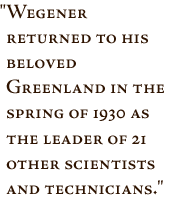

|
Wegener returned to his beloved Greenland in the spring of 1930 as the leader of 21 other scientists and technicians. They were to systematically study the great ice cap and its climate. To carry out this ambitious program, Wegener planned to establish three observation posts at latitude 71 degrees N, one on the western edge of the ice, one on the eastern edge, and one at mid-ice. From the beginning, things went badly. Though the main party arrived in western Greenland on April 15, harbor ice hung on stubbornly until June 17, when they were finally able to land their 98 tons of supplies at the base of the ice cap. They were already 38 days behind schedule when they began to move up onto the ice cap to set up the western camp. On July 15, a small party headed inland, establishing the mid-ice camp, "Eismitte," on July 30. It was 250 miles inland at an elevation of 9,850 feet. (The eastern station was established later, by a separate party that landed on the east coast.) Because of unusually frequent bad weather, only a fraction of the supplies meteorologist Georgi and glaciologist Ernest Sorge would need for the harsh Greenland winter reached Eismitte in the next month and a half. Even the hut they were to live in and their radio transmitter didn't get through. Wegener had earlier written his brother Kurt of the polar explorer's "obligation to be a hero." This was doubly true for an expedition leader, so on September 21 Wegener himself led a 15-dogsled run to relieve Eismitte. He was accompanied bv fellow meteorologist Fritz Lowe and 13 Greenlanders. Because of poor snow conditions and bad weather, however, they covered only 38.5 miles the first seven days. Wegener wrote it was now "a matter of life and death" for his friends at Eismitte. As the relief party continued to struggle eastward, all but one of the Greenlanders gave up and returned to the base camp. Wegener and his two remaining companions finally reached Eismitte on October 30, after traveling 40 days. For the last five days temperatures had averaged -58 degrees F and a constant, frigid wind had blown in their faces. At Eismitte, the travelers were delighted to find that Georgi and Sorge had been able to dig an ice cave for shelter; moreover, they thought they could stretch their supplies through the winter. The heroic rescue run had been unnecessary, but there had been no way to let Wegener know. Fritz Lowe was exhausted and his feet and fingers were badly frostbitten. Wegener, on the other hand, "looked as fresh, happy and fit as if he had just been for a walk," marveled Ernst Sorge. "He was fired with enthusiasm and ready to tackle anything." Rasmus Villumsen, the 22-year-old Greenlander who had accompanied them, was also in good shape. Two days later, on November 1, the group gaily celebrated Wegener's 50th birthday. Then, because supplies were short and Fritz Lowe had to stay to recuperate, Wegener and Rasmus Villumsen, the wind now at their backs, set off confidently for the coast. Their friends would never see them alive again.
When Wegener, Lowe, and Villumsen failed to return, those at the base camp assumed they had decided to overwinter at Eismitte. When April came with no word, however, they sent out a search party to make sure. Some 118 miles inland the searchers came upon a pair of skis stuck upright in the snow, with a broken ski pole lying between them. They dug around, but found only an empty box. Puzzled, they went on to Eismitte, but when they heard Wegener and Villumsen had left six months before, they hurried back to make a more thorough search. On May 12, 1931, they found Wegener's body. It was fully dressed and lying on a reindeer skin and sleeping bag stitched into two sleeping bag covers. Wegener's eyes were open, and the expression on his face was calm and peaceful, almost smiling. Apparently he died while lying in his tent. His friends thought Wegener probably suffered a heart attack brought on by the tremendous exertion of trying to keep up with the dogsled on skis over rough terrain. Rasmus Villumsen obviously buried Wegener with great care and respect, then presumably pressed on for the base camp, only to disappear into the white wilderness. Though a long, exhaustive search was made, the faithful Greenlander's body was never found. Wegener's friends left his body as they found it and built an ice-block mausoleum over it. Later they erected a 20-foot iron cross to mark the site. All have long since vanished beneath the snow, inevitably to become part of the great glacier itself. It is a most fitting resting place for this remarkable man who devoted so much of his life to the study of that remnant of the last ice age and whose vision of moving continents provided the key to the mysteries of more ancient glacial epochs. next: Recommended Reading
|
 On the Shoulders of Giants
| ||